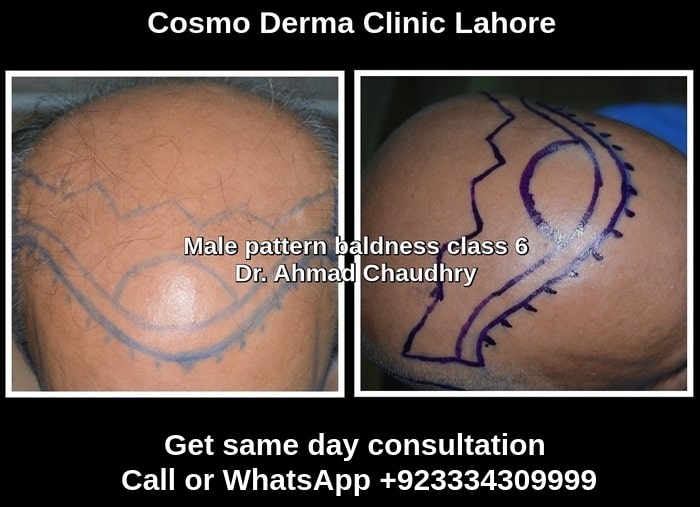Hair graft replacement Lahore is performed for baldness treatment through two techniques called FUE & FUT. It is a surgical procedure that involves the removal of follicles from one part of the body, known as the donor site, and their implantation onto a bald or thinning area of the scalp, referred to as the recipient site. This technique has gained significant popularity over the years as a reliable and effective solution for baldness. It not only restores a natural hairline but also boosts self-confidence and improves the overall appearance of the individual. This procedure is suitable for individuals experiencing male & female pattern baldness or those seeking to enhance their hairline or eyebrow density.
Hair graft replacement Lahore phase 4 DHA patient details
| Procedure date | 16 Aug 2023 |
| Patient age | 62 years |
| Plan | Front zones |
| Technique | DHI – Fue |
| Donor area | Back & sides |
| Punch | 0.9 mm |
| Surgeon | Dr. Ahmad Chaudhry |
| Contact | +923334309999 |
Purpose:
The primary purpose of this technique is to combat alopecia caused by various factors, such as genetics, aging, hormonal imbalances, trauma, or medical conditions. Hair loss can be emotionally distressing, affecting one’s self-esteem and self-image. By restoring natural hair growth in bald or thinning areas, hair transplant surgery aims to improve the patient’s confidence, appearance, and overall quality of life as required by an individual.
Hair restoration methods
There are two main methods used for hair graft replacement:
1. Follicular Unit: Transplantation (FUT): This technique involves the extraction of a strip of skin from the donor site, typically the back or sides of the scalp, where it is in various types. The strip is then cut up into individual follicular units under a microscope and transplanted into tiny incisions made in the recipient site. FUT allows for the transplantation of a large number of grafts in a single session, making it suitable for patients requiring extensive hair restoration.
2. Follicular Unit Extraction: (FUE): FUE is a more advanced technique that involves the extraction of individual follicular units directly from the donor site using punches or specialized instruments. These follicular units are carefully implanted into the recipient site, taking off natural hair growth patterns. FUE is a minimally invasive procedure and leaves no linear scar at the donor site, allowing patients to wear their hair short without any visible signs of surgery.
Both FUT and FUE methods require accuracy and skill to ensure a successful outcome. Expert hair transplant surgeons consider numerous factors, such as age, hair quality, hair loss pattern, and individual expectations, to determine the most suitable method for each patient.
Advantages:
This technique offers several advantages, making it a preferred choice for individuals seeking a permanent solution. Some key benefits include:
1. Natural results: The transplanted follicles are taken from the patient,s own scalp, ensuring a natural-looking hairline and growth pattern.
2. Permanent solution: The transplanted grafts are resistant to shedding, as they are typically taken from areas genetically programmed to resist balding.
3. Minimal downtime: Patients can resume their daily activities within a few days. The healing process is relatively quick, and the transplanted hair starts growing within a few months.
4. Minimal scarring: With FUE, there is no linear scar, only tiny dots that are hardly noticeable, allowing patients the freedom to wear their hair short.
Surgical Instruments:
Hair graft replacement surgeries require the use of specialized surgical instruments to ensure accurate and efficient transplantation. Some common instruments used in these procedures include:
1. Microscope: A high-powered microscope is used to cut off the extracted follicles into individual grafts, ensuring accuracy during the procedure.
2. Punches: Punches are small instruments used in FUE surgeries to extract individual follicles. These punches vary in size, allowing surgeons to match the diameter to the specific grafts they aim to take in.
3. Implanters: Implanters, also known as Choi pens, are used to create tiny incisions in the recipient area and carefully place follicles. These devices help to ensure proper measurement and density during implantation.
4. Forceps: Fine-tipped forceps are utilized to handle extracted follicles, ensuring less damage during the transplantation process. These instruments are vital for maintaining the integrity of the grafts.
Staff Training:
Performing hair graft replacement surgeries requires a highly skilled and trained surgical team. Surgeons specializing in hair transplantation typically complete extensive training programs to refine their technique and ensure patient safety and satisfaction. Additionally, the surgical staff, including nurses and technicians, receive thorough training on handling the surgical instruments, proper graft extraction and implantation, and post-operative care. Ongoing training and staying updated with the latest advancements in graft replacement techniques are necessary for the entire staff to provide maximum patient outcomes.
Conclusion:
In conclusion, hair graft replacement offers a solution for individuals facing baldness or thinning. Through many techniques such as FUT and FUE, along with the use of specialized surgical instruments, patients can achieve natural-looking results and enhance their overall appearance. The training and expertise of the surgical staff play a significant role in ensuring the success of these procedures, highlighting the importance of continuous professional development and staying on a level of advancements in the field. Hair graft replacement, through FUT or FUE techniques, has revolutionized the treatment of hair loss, allowing individuals to regain their confidence and achieve natural-looking results. The purpose of this procedure is not only to restore hair growth but also to boost self-esteem. The advanced methods used in this technique permanent results with less scarring and downtime. If you are considering hair transplant surgery, consult with a skilled and experienced
surgeon to determine the most suitable method for your individual needs.
People also search
| 2213 grafts before after | 2876 grafts before after |
| 3100 grafts | 2786 grafts before after |
Free consultation | Call or WhatsApp | +923334309999


